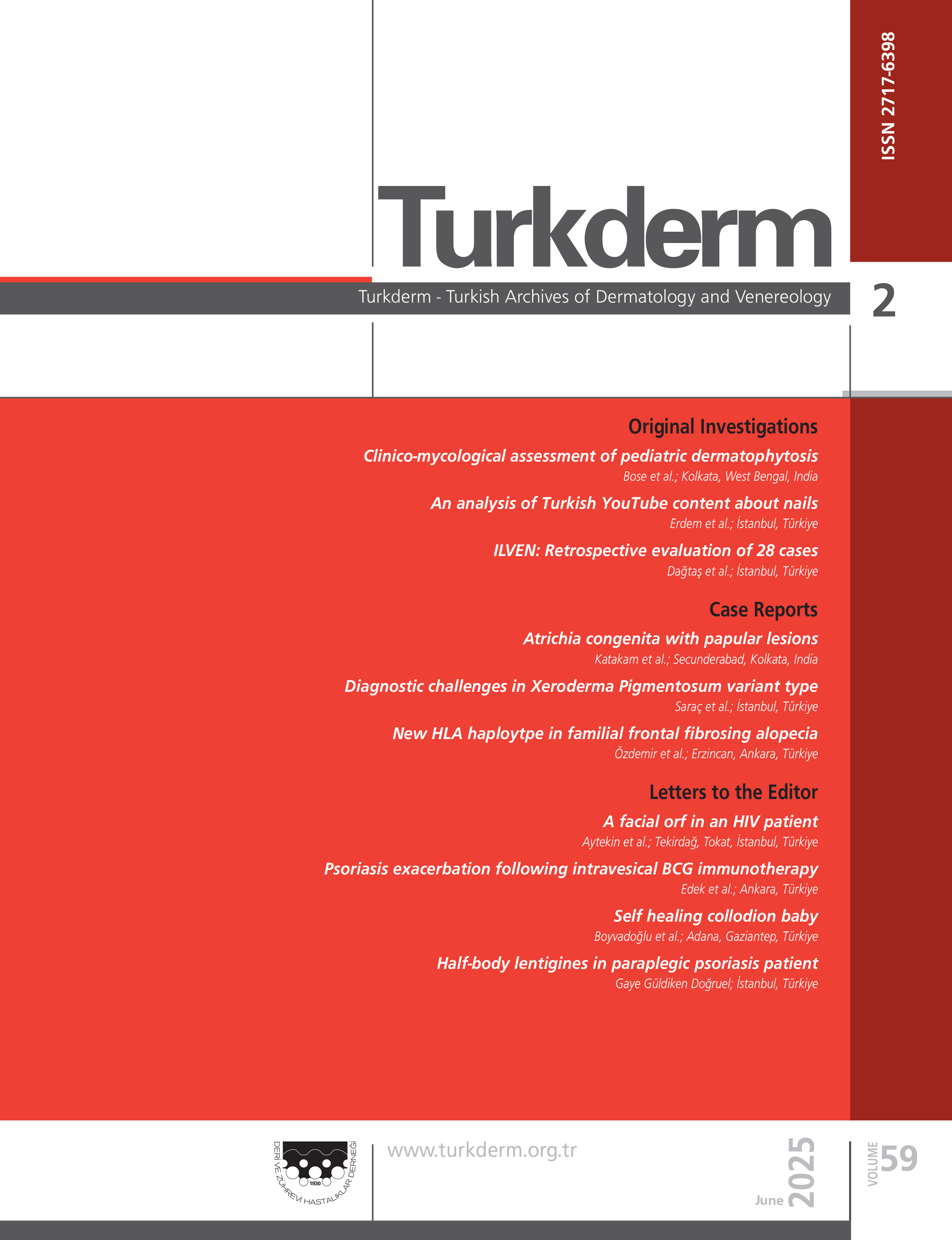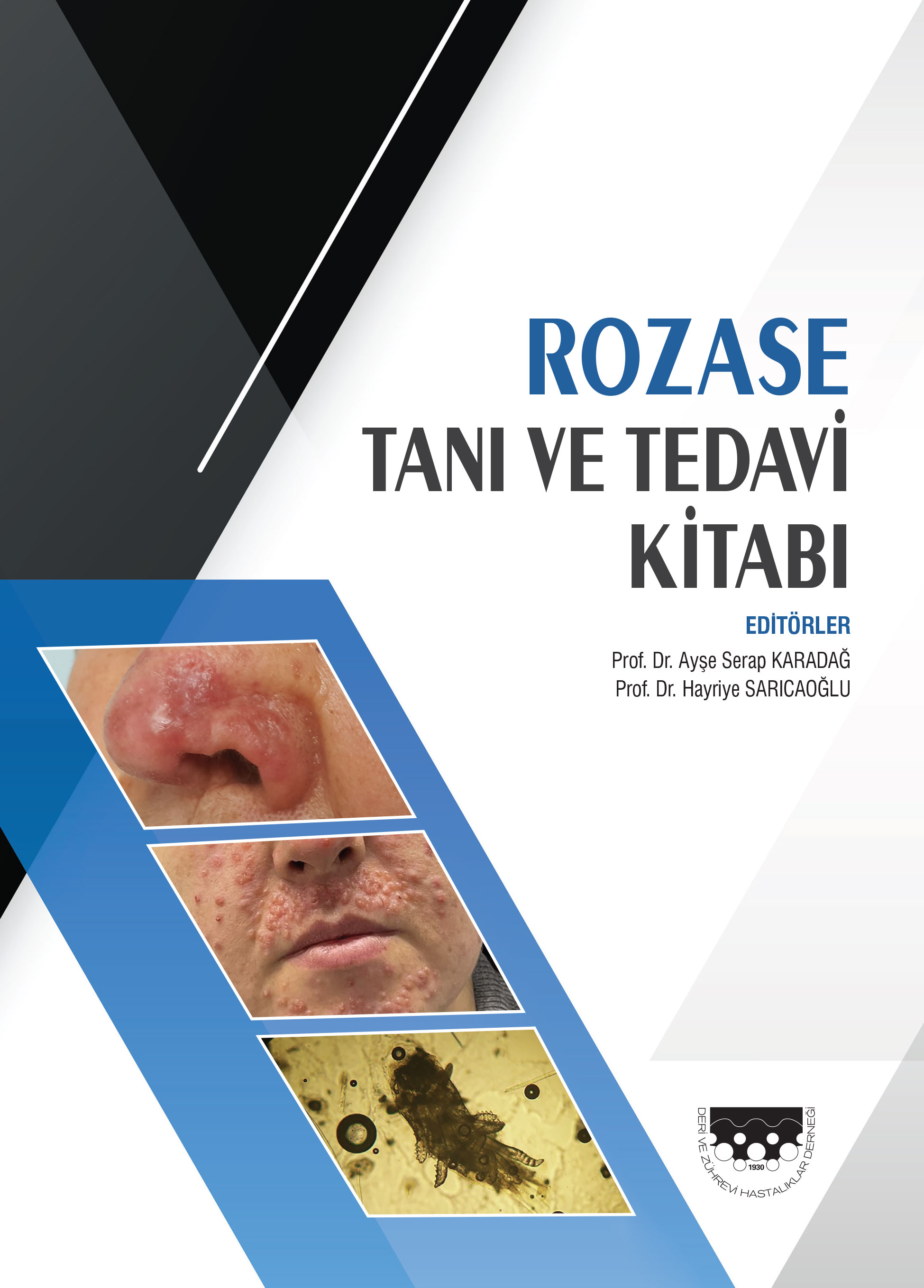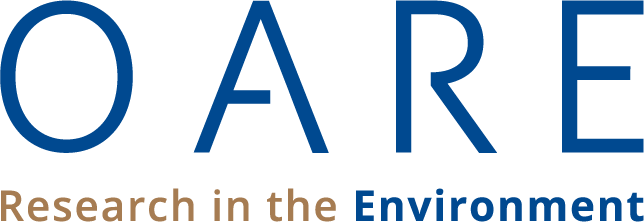Volume: 56 Issue: 4 - 2022
| 1. | Cover Pages I - VII |
| REVIEW ARTICLE | |
| 2. | Dermatological adverse effects of COVID-19 vaccines Elçin Akdaş, Nilsel İlter doi: 10.4274/turkderm.galenos.2022.57224 Pages 147 - 153 Studies for vaccine development have been completed in an unprecedented time to prevent further outbreak of the dangerous and potentially fatal coronavirus disease-2019 (COVID-19) caused by severe acute respiratory syndrome-coronavirus-2 (SARS-CoV-2). Some of these vaccines have been approved by various authorities and made available worldwide. While vaccine applications continue globally, the number of dermatological side effects reported after vaccination is increasing daily. Many cutaneous reactions have been reported in the literature, such as injection site reactions, pernio lesions, pityriasis rosacea, herpes zoster, and exacerbations of chronic inflammatory dermatoses such as atopic dermatitis and psoriasis. Most COVID-19 vaccines require two doses and a booster dose, and considering the new variants of the coronavirus, vaccination is estimated to continue for a while. In this context, dermatologists are more likely to encounter vaccine-related dermatological side effects in their daily practice. Dermatologists play an essential role in many issues such as diagnosis and treatment of cutaneous reactions after COVID-19 vaccination, informing patients and providing necessary counseling. This perspective will also provide helpful information for the future in terms of vaccination strategies to be developed for repeated doses. In this study, most of the cutaneous reactions reported after COVID-19 vaccination in the current literature are reviewed. |
| ORIGINAL INVESTIGATION | |
| 3. | Internalized stigma in patients with verruca Esra Inan Doğan, Birgül Özkesici Kurt doi: 10.4274/turkderm.galenos.2022.75725 Pages 154 - 158 Background and Design: Internalized stigma is the acceptance of negative stereotypes about the disease created by society and withdrawing of oneself from society with emotions such as worthlessness and shame. This study aimed to investigate the internalized stigma status of patients with verruca. Materials and Methods: A total of 58 patients with verruca were included in this study. The sociodemographic and clinical characteristics of these patients were recorded. The Internalized Stigma Scale (ISS) was used. In addition, patients answered the 12-Item General Health Questionnaire-12 (GHQ-12) and the Perceived Health Status question. Results: The mean ISS total score was 52.17±14.73. Cronbachs alpha coefficient for the whole scale for patients with verruca was 0.92. Among the five ISS subscales in patients with verruca, the lowest internal consistency was found in the stigma resistance subscale (Cronbachs alpha coefficient: 0.572), and the highest internal consistency was in the social withdrawal subscale (Cronbachs alpha coefficient: 0.890). A significant correlation was found between the GHQ-12 and ISS total or ISS subscales, except for the stigma resistance subscale (p<0.05). Conclusion: This study revealed that patients with verruca internalize the negative stereotypes of society about the disease. High levels of internalized stigma were related to poor GHQ scores. This may indicate that internalized stigma is associated with depression in patients with verruca. Thus, the psychosocial aspects of patients with verruca should be evaluated. |
| 4. | Precancerous skin lesions and malignant skin tumors associated with hydroxyurea treatment: Evaluation of a large series and review of the literature Can Baykal, Kübra Nursel Bölük, Sıla Kılıç Sayar, Şule Öztürk Sarı, Amid Mahmudov, Nesimi Büyükbabani doi: 10.4274/turkderm.galenos.2022.91489 Pages 159 - 165 Background and Design: Malignant skin tumors have been reported in patients using hydroxyurea (HU) for hematological disorders. This study aimed to investigate the characteristics of precancerous skin lesions and malignant skin tumors in association with long-term HU therapy. Materials and Methods: Records of consecutive patients diagnosed with precancerous and cancerous skin lesions during HU therapy in a single dermatology department between 2008 and 2021 were retrospectively analyzed. Results: Among 13 patients (mean age: 66.5 years) treated with HU for five different hematological diseases, 11 had used HU >5 years, whereas the time was shorter in the other two patients. The period between HU treatment initiation and the appearance of the first lesion was approximately 9-10 years. Actinic keratosis (AKs) were found in two patients, non-melanoma skin cancers (NMSCs) accompanied by AKs in seven patients, and only NMSCs in four patients. Melanoma was seen in a patient with NMSCs and AKs. In total, 12 basal cell carcinomas (BCCs), 12 squamous cell carcinomas (SCCs), and one melanoma were diagnosed. The superficial type was the most common type of BCCs, followed by the nodular type. NMSCs were located mainly on the face, followed by the scalp, neck, and extensor surfaces of the upper extremities. Conclusion: The results of this large series support the possibility of the relationship between UV-induced skin cancer and HU therapy. SCCs and BCCs showed equal incidence in the present study in contrast to some previous reports, and different BCC types may occur in these patients. As many patients have more than one malignant skin tumor, protective measures against sunlight, which is another inducing factor for these tumors, and a long-term follow-up, should not be ignored. |
| 5. | Evaluation of the quality, reliability, and popularity of Turkish YouTube videos on acne treatment Özge Kaya, Sezgi Sarikaya Solak doi: 10.4274/turkderm.galenos.2022.09623 Pages 166 - 171 Background and Design: Social media is extremely popular for obtaining information on dermatological diseases and their treatments. The present study aimed to evaluate Turkish YouTube videos on acne treatment and compare them in terms of quality, reliability, and popularity based on the upload source. Materials and Methods: The first 120 Turkish YouTube videos on acne treatments were reviewed. The number of views, likes, dislikes, comments, video age, and video length were recorded. The quality and reliability of the videos were evaluated with the video power index (VPI). Then, the findings were compared based on the upload source. Results: A total of 104 videos uploaded by 52 physicians and 52 non-physicians (female: male ratio: 3.3: 1) were assessed in this study. The DISCERN Score and Global Quality Score (GQS) were higher in the physicians group (n=52, 50%) (p<0.001). The number of views, likes, dislikes, comments and VPI were significantly higher in the non-physicians group. The time elapsed since the upload day was longer in the videos uploaded by physicians, and the video duration was longer in the videos uploaded by non-physicians (p<0.001). The DISCERN and GQS in videos uploaded by dermatologists (n=30, 54%) were higher (p<0.001) than in those uploaded by non-dermatologists (n=22, 46%). No statistically significant difference was found in other findings. Conclusion: This study's findings confirmed that Turkish YouTube videos on acne treatment uploaded by doctors, especially dermatologists, were of higher quality and reliable, albeit with lower viewing rates and popularity. |
| 6. | Dermatological diseases in immigrants with Fitzpatrick skin types 5-6 evaluated in a tertiary health center Elif Afacan Yıldırım, Yusuf Can Edek, Esra Adışen doi: 10.4274/turkderm.galenos.2022.82084 Pages 172 - 177 Background and Design: Dermatologists have limited experience with dermatological diseases seen in immigrants with Fitzpatrick skin types 5-6 in Turkey, which can cause difficulties in diagnosis. This study aimed to examine the clinical and demographic characteristics of this patient population evaluated in a tertiary health center. Materials and Methods: All patients with Fitzpatrick skin types 5-6 who applied to our dermatology outpatient clinic between June 1, 2018, and July 15, 2021, were included in this single-center, retrospective study. All data were obtained from the electronic database. Results: The study included 65 patients with Fitzpatrick skin types 5-6 from 14 countries. Overall, 37 of the patients were female and 28 were male, and the mean age was 30.7±15.54 years. The patients were most commonly from East Africa (76.9%), and 38 (58.5%) patients were from Somalia. The most common diagnoses were acne (21.5%), infections (20.0%), dermatitis (12.3%), pigmentation disorders (9.2%), and xerosis cutis (9.2%). Biopsy was taken from 6 (9.2%) patients. As regards treatment, only topical treatment was recommended in 55.4%, topical and systemic treatment in 26.1%, systemic treatment in 4.6%, cryotherapy/surgical methods in 6.1%, and further examination in 7.7% of the cases. Conclusion: Acne, dermatitis, pigmentation disorders, and alopecia, which are common diagnoses in our study, are consistent with the diagnoses reported most frequently in patients with Fitzpatrick skin type 5-6. The finding that infections (20.0%) were among the most common diagnoses in our study may be related to the difficult living conditions of this patient population as they are immigrants. Thus, physicians should recognize common dermatological diseases in individuals with Fitzpatrick skin types 5-6. Our results may guide further studies in determining the medical needs of this patient group and planning dermatological care appropriately. |
| 7. | Could distress tolerance levels be associated with the severity of chronic spontaneous urticaria? Neşe Göçer Gürok, Mehmet Gürkan Gürok, Savaş Öztürk doi: 10.4274/turkderm.galenos.2022.46793 Pages 178 - 182 Background and Design: Chronic spontaneous urticaria (CSU) is a common disease characterized by erythematous and itchy wheals, angioedema, or both that last for >6 weeks. Its etiology is not yet fully determined. This study aimed to analyze the distress tolerance (DT) levels of patients with CSU and correlations between DT and clinical parameters and other psychological symptoms. Materials and Methods: Fifty-two patients with CSU without any concomitant diseases were included in the study. The control group included 50 healthy volunteers with similar baseline demographics but without physical or psychiatric diseases. The urticaria activity score 7 (UAS7) was used to determine the disease severity in the patient group. In both groups, Sociodemographic and Clinical Data Form, Distress Tolerance Scale (DTS), Beck Depression Inventory (BDI), and state and trait anxiety inventory were used. Statistical differences in psychiatric scale scores were found between the patient and control groups, and a correlation was found between UAS7 and scale scores in the patient group. Results: No differences in sociodemographic variables were found between the patient and control groups. The DTS and subgroup score analysis revealed statistically significant differences between the patient and control groups. The DTS-total scores (p<0.001), DTS tolerance subdimension scores (p<0.001), DTS self-efficacy subdimension scores (p=0.002), and DTS regulation subdimension scores (p=0.02) were statistically lower in the patient group than in the control group. The BDI (p<0.01) and anxiety scores (state, p<0.001; trait, p=0.002) were also higher in the patient group than in the control group. Furthermore, a positive correlation was found between UAS7 scores and all scale scores. Conclusion: Psychological disorders are prevalent in patients with CSU and exhibit an interaction with the prognosis. Although the interaction is well-known, no clear multidisciplinary approach has been established for patients with CSU. In this study, DT was significantly reduced in patients with CSU, and a positive correlation may exist between disease severity and psychological symptoms. Thus, the evaluation of DT in patients with CSU could be addressed in psychotherapy and might be a beneficial criterion not only for the treatment but also for disease severity. |
| CASE REPORT | |
| 8. | An unusual presentation of linear immunoglobulin A dermatosis after coronavirus disease-2019 mRNA vaccine Elif Eriş, Yunus Özcan, Belkız Uyar, Mehmet Gamsızkan doi: 10.4274/turkderm.galenos.2022.38387 Pages 183 - 185 Linear immunoglobulin A bullous dermatosis (LABD) is a rare subepidermal vesiculobullous disease that can develop in children and adults. Although most cases are idiopathic, drugs, infections, and malignancies have also been reported to induce LABD. In this report, we present the case of a 43-year-old female patient who developed LABD with an unusual clinical appearance shortly after immunization with the coronavirus disease-2019 mRNA vaccine. |
| 9. | Scleredema of Buschke in a little child and its successful treatment with ultraviolet A1 phototherapy Damla Demir, Müge Göre Karaali, Filiz Cebeci Kahraman, İlkin Zindancı, Ebru Zemheri doi: 10.4274/turkderm.galenos.2022.51261 Pages 186 - 189 A 5-year-old girl with skin hardness and thickening was admitted to our clinic and diagnosed with scleredema of Buschke clinically and histopathologically. Ultraviolet A1 (UVA1) phototherapy at a dose of 30 J/cm2 was planned for 3 days in 1 week. After 45 UVA1 phototherapy sessions (with a cumulative dose of 1350 J/cm2), clinical complete remission was achieved. Ultrasonography revealed improvement in skin thickening, and no recurrence was noted in the 2-year follow-up period. |
| 10. | Plaque-like dermatofibroma: A case report and review of the literature Sinan Nane, Aslı Bilgiç, Cumhur İbrahim Başsorgun, Erkan Alpsoy doi: 10.4274/turkderm.galenos.2022.38107 Pages 190 - 192 Dermatofibromas are common skin tumors although there are some different clinical forms, which are seen rarely. Giant dermatofibromas are benign, pedunculated lesions that are larger than 5 cm with typical dermatofibroma histopathologic features. Typically, plaque-like dermatofibromas are considered a subtype of giant dermatofibromas without a pedicule. Here, we aimed to report a case of plaque-like dermatofibroma seen in a 5-year-old girl due to its rarity and to review this clinical picture together with all the cases in the literature. |
| 11. | Anti-MDA5 antibody-positive dermatomyositis with severe cutaneous ulcers Büşra Demirbağ Gül, Nilgün Şentürk, Deniz Bayçelebi, Levent Yıldız doi: 10.4274/turkderm.galenos.2022.82881 Pages 193 - 196 Anti-melanom farklılaşması ile ilişkili protein 5 (anti-MDA5) antikoru pozitif dermatomiyozit (DM), son zamanlarda tanımlanmış bir DM alt tipidir. Klasik DM ile karşılaştırıldığında kutanöz ülserler, interstisyel akciğer hastalığı (İAH), artrit ve daha az kas tutulumu görülmesi gibi atipik özelliklere sahiptir. Burada, semptomları elektrik travması sonra başlayan, şiddetli kutanöz ülserli, anti-MDA5 antikoru pozitif DM tanısı konan bir hastayı sunduk. Otuz üç yaşında erkek hasta son iki aydır gelişen deri döküntüsü, artralji, halsizlik şikayetleri ile kliniğimize başvurdu. Özgeçmişinde bir ay önce düşük voltajlı elektrik travması geçirdiği öğrenildi. Fizik muayene, laboratuvar, radyoloji bulguları, deri histopatolojisine göre DM tanısı konuldu. Oral prednizolon 1 mg/kg/gün ve intravenöz immünoglobulin 2 g/kg/ay tedavisi başlandı. Başlangıçta semptomlar düzeldiği için prednizolon dozu kademeli olarak azaltıldı. Üçüncü vizitte hasta kutanöz ve mukozal ülserlerle tarafımıza başvurdu. Bu noktada, genişletilmiş miyozit antikor paneli testi gönderildi ve anti-MDA5 antikorunun varlığı tespit edildi. Yüksek çözünürlüklü bilgisayarlı tomografide, her iki akciğerde erken İAH anlamına gelen periferik intralobüler retiküler opasiteler görüldü. Bu nedenle steroid ve intravenöz immünoglobulin tedavsine ek olarak ayda bir kez 1000 mg intravenöz siklofosfamid eklendi. Hastanın tedavisi dramatik bir iyileşme ile birlikte devam ediyor. Anti-MDA5 pozitif DM, hızlı ilerleyen İAH geliştirme açısından önemli bir riske sahiptir, bu nedenle zamanında teşhis, prognoz için kritik öneme sahiptir. |
| LETTER TO THE EDITOR | |
| 12. | Secukinumab-induced paradoxical palmoplantar pustular psoriasis Yıldız Gürsel Ürün, Hande Yelgen, Mustafa Ürün, Nuray Can doi: 10.4274/turkderm.galenos.2022.39591 Pages 197 - 199 Abstract | |
| INDEX | |
| 13. | Subject Index Pages E1 - E3 |
| 14. | Referee Index Page E4 |
| 15. | Author Index Pages E5 - E6 |























